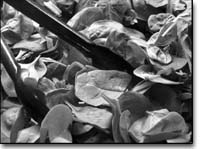|
|
||
|
Eats yer spinach by Chef Boy Ari At the salad bar these days, I forgo lettuce entirely. Nothing against lettuce, but where else do you have to pay $5 to $8 a pound for it? On the other hand, a plate full of baco-bits represents quite a savings over what it would cost to make bacon at home. But alas, even I, bacon-hugger to the core, might find a full plate of bacon too much. So I build my salad around a whopping pile of the baby green that eats like a meal: as fleshy as bacon, with none of the fat or dead animal karma. And I’m not the only one wolfing down spinach. In my lifetime, U.S. consumption has quintupled. Americans haven’t eaten this much spinach (2.4 pounds per year per capita, according to the USDA) since the 1950s, when Popeye gave the industry a boost. Back then, spinach was usually eaten from cans. Today, Americans like their spinach fresh and young – although not necessarily in that order. Baby spinach is the nation’s new green darling, according to a recent Bon Appetit survey of diners’ favorite vegetables. People are buying pre-washed baby spinach by the bag, mostly grown in the Southwest. Me, I like my baby spinach. But it doesn’t compare to a succulent, dinnerplate-sized leaf, fresh from the ground. In the same family as beet and chard, spinach is thought to have originated in ancient Persia, aka Iran. Spinach arrived, via Nepal, in 17th-century China, where it is still called “Persian Greens.” Spinach didn’t hit Europe until the 11th century, when the Moors brought it to Spain. Known for a while in England as “the Spanish vegetable,” the name was shortened and modified to “spinach,” before Popeye lengthened it to spinachk. Spinach’s list of nutritional qualities stretches longer than Olive Oyl’s legs. Vitamins, minerals, protein, fiber, folic acid, omega-3 fatty acids, antioxidants, iron, you name it – but if iron is what you are after, make sure to cook the spinach with lemon or some other acid, which makes that rust-prone nutrient more accessible.
cook the spinach with lemon or some other acid, which makes that rust-prone nutrient more accessible. According to the Environmental Working Group, spinach is one of the 12 common food crops most likely to be contaminated by pesticide residue. The most common pesticides found on spinach are permethrin, dimethoate, and – get this – DDT, which is known to cause cancer, birth defects and reproductive damage. Wait a minute … wasn’t Dichlorodiphenyltri-chloroethane (DDT) banned in 1972? Banned for use in the U.S., yes. But we continue to manufacture and export it by the ton to developing nations. One of the reasons, arguably a good one, is DDT’s mosquito-killing power, which is a big help in the global fight against malaria. But it’s no secret that farmers in developing nations still use DDT on their crops, and the joke is on us when some imported spinach is found to contain significant traces of DDT. The other reason DDT is found on spinach is that it persists in the environment for years. Domestic spinach can still contain traces of DDT that was sprayed before 1972. Pesticides, so the saying goes, don’t know when to stop killing. Thus, more than almost any other item of produce, spinach should be purchased in organic form. While most of the nation’s spinach is grown in California, Texas and Arizona, this time of year it shouldn’t be hard to find local, organic spinach. The Farmer’s Market is the most obvious place, followed by stores that make an effort to market local produce. When heated, spinach cooks down remarkably. If you want to cook it at all, baby spinach can be tossed onto a dish as it’s leaving the stove, and the heat of the food will wilt it. But if you have a nice quantity of spinach, you might want to try the following Indian dish called saag paneer, which means “spinach and cheese” in Hindi. Fry half a cup of chopped onion or shallots in two tablespoons butter. Add ¼ teaspoon salt and 1 tablespoon garam masala, an Indian spice mixture available at many stores and online. Let this cook together for a few minutes, then add the equivalent of two bunches of spinach to the pan, and half a cup of cheese curds. Season with salt to taste. Cook with the lid on until the curds are soft. My final suggestion is an in-house creation I call “Scrambled Spinach Omelet.” If you’re not a bacon-hugger, you can skip the pork belly and substitute oil. Otherwise, begin by preparing the pan with a strip of chopped bacon. While it’s cooking, add chopped onion and peppers, if you like those things. Meanwhile, beat as many eggs as you want to eat, beating in salt, pepper and mashed or pressed garlic. When the stuff in the pan is almost ready, pour in the eggs. While the eggs begin to cook, drop little dollops of cheese (I like brie, chevre and/or parmesan) on top of the gently cooking egg pancake. Then add a whopping handful of baby or chopped spinach. When you smell the eggs starting to cook, stir the contents of the pan until the eggs are cooked to your liking. You’ll be full to the finich, if you eatsk this scrambled Persian Greens omelet. •
|


